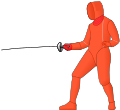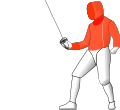Fencing
Fencing is a sport that involves two competitors who attempt to score points by making contact with their opponent using a rapier-like weapon. The sport has its roots in the dueling practices of the 18th century and has evolved into a modern competitive sport with a variety of different styles and techniques.
History[edit]
Fencing originated in Spain, where it was known as esgrima. It was later adopted by the French and Italians, who developed their own unique styles of the sport. The sport was included in the first modern Olympic Games in 1896 and has been a part of the games ever since.
Equipment[edit]
Fencing requires a variety of equipment to ensure the safety of the competitors. This includes a mask, a jacket, a plastron (an underarm protector), a glove, and a weapon. There are three types of weapons used in fencing: the foil, the épée, and the sabre, each with its own unique rules and scoring system.
Rules and Scoring[edit]
In fencing, points are scored by making contact with the opponent's target area with the weapon. The target area varies depending on the type of weapon used. In foil fencing, the target area is the torso; in épée fencing, the entire body is the target; and in sabre fencing, the target area is everything above the waist.
Techniques[edit]
There are a variety of techniques used in fencing, including attacks, parries, and ripostes. These techniques require a high level of skill and precision, and are often the deciding factor in a match.
Health Benefits[edit]
Fencing is a physically demanding sport that provides a number of health benefits. It improves cardiovascular fitness, increases flexibility, and enhances coordination and balance. It also provides mental benefits, such as improved concentration and strategic thinking.
See Also[edit]
Ad. Transform your life with W8MD's Budget GLP-1 injections from $75


W8MD offers a medical weight loss program to lose weight in Philadelphia. Our physician-supervised medical weight loss provides:
- Weight loss injections in NYC (generic and brand names):
- Zepbound / Mounjaro, Wegovy / Ozempic, Saxenda
- Most insurances accepted or discounted self-pay rates. We will obtain insurance prior authorizations if needed.
- Generic GLP1 weight loss injections from $75 for the starting dose.
- Also offer prescription weight loss medications including Phentermine, Qsymia, Diethylpropion, Contrave etc.
NYC weight loss doctor appointmentsNYC weight loss doctor appointments
Start your NYC weight loss journey today at our NYC medical weight loss and Philadelphia medical weight loss clinics.
- Call 718-946-5500 to lose weight in NYC or for medical weight loss in Philadelphia 215-676-2334.
- Tags:NYC medical weight loss, Philadelphia lose weight Zepbound NYC, Budget GLP1 weight loss injections, Wegovy Philadelphia, Wegovy NYC, Philadelphia medical weight loss, Brookly weight loss and Wegovy NYC
|
WikiMD's Wellness Encyclopedia |
| Let Food Be Thy Medicine Medicine Thy Food - Hippocrates |
Medical Disclaimer: WikiMD is not a substitute for professional medical advice. The information on WikiMD is provided as an information resource only, may be incorrect, outdated or misleading, and is not to be used or relied on for any diagnostic or treatment purposes. Please consult your health care provider before making any healthcare decisions or for guidance about a specific medical condition. WikiMD expressly disclaims responsibility, and shall have no liability, for any damages, loss, injury, or liability whatsoever suffered as a result of your reliance on the information contained in this site. By visiting this site you agree to the foregoing terms and conditions, which may from time to time be changed or supplemented by WikiMD. If you do not agree to the foregoing terms and conditions, you should not enter or use this site. See full disclaimer.
Credits:Most images are courtesy of Wikimedia commons, and templates, categories Wikipedia, licensed under CC BY SA or similar.
Translate this page: - East Asian
中文,
日本,
한국어,
South Asian
हिन्दी,
தமிழ்,
తెలుగు,
Urdu,
ಕನ್ನಡ,
Southeast Asian
Indonesian,
Vietnamese,
Thai,
မြန်မာဘာသာ,
বাংলা
European
español,
Deutsch,
français,
Greek,
português do Brasil,
polski,
română,
русский,
Nederlands,
norsk,
svenska,
suomi,
Italian
Middle Eastern & African
عربى,
Turkish,
Persian,
Hebrew,
Afrikaans,
isiZulu,
Kiswahili,
Other
Bulgarian,
Hungarian,
Czech,
Swedish,
മലയാളം,
मराठी,
ਪੰਜਾਬੀ,
ગુજરાતી,
Portuguese,
Ukrainian














